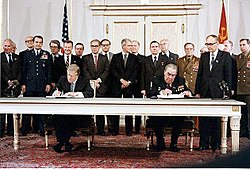Strategic Arms Limitation Talks
The Strategic Arms Limitation Talks (SALT) were two rounds of bilateral conferences and corresponding international treaties involving the United States and the Soviet Union.Although SALT II resulted in an agreement in 1979 in Vienna, the US Senate chose not to ratify the treaty in response to the Soviet invasion of Afghanistan, which took place later that year.The Soviet Union had deployed such a system around Moscow in 1966, and the United States announced an ABM program to protect twelve ICBM sites in 1967.Negotiations lasted from November 17, 1969, to May 26, 1972, in a series of meetings beginning in Helsinki, with the American delegation headed by Gerard C. Smith, director of the Arms Control and Disarmament Agency.One problem that he ran into was that limitation strategies weren't working and open to full of critiques, and the U.S. alongside Soviet continued to make new ballistic missiles.David Tal argues: The linkage between strategic arms limitations and outstanding issues such as the Middle East, Berlin and, foremost, Vietnam thus became central to Nixon's and Kissinger's policy of détente.It failed mainly because it was based on flawed assumptions and false premises, the foremost of which was that the Soviet Union wanted strategic arms limitation agreement much more than the United States did.[10]The agreement paved the way for further discussion regarding international cooperation and a limitation of nuclear armaments, as seen through both the SALT II Treaty and the Washington Summit of 1973.An agreement to limit strategic launchers was reached in Vienna on June 18, 1979, and was signed by Brezhnev and Carter at a ceremony held in the Redoutensaal of the Hofburg Palace.
SALT (disambiguation)Cold WarOriginsWorld War IIHiroshima and NagasakiAftermathEastern BlocWestern BlocIron CurtainCold War (1947–1948)Cold War (1948–1953)Cold War (1953–1962)Cold War (1962–1979)Cold War (1979–1985)Cold War (1985–1991)Frozen conflictsTimeline of eventsHistoriographyRelated conflictsPost–Cold War eraRelations since 1989Second Cold WarPost-Soviet conflictsArab Cold WarCold War in AsiaReagan Doctrinebilateralinternational treatiesUnited StatesSoviet Unionsuperpowersarms controlHelsinkiAnti-Ballistic Missile TreatyViennaUS SenateSoviet invasion of AfghanistanSupreme SovietSTART ISTART IINew STARTsubmarine-launched ballistic missileintercontinental ballistic missilemultiple independently targetable reentry vehicledummiesanti-ballistic missileMoscowR-36 missileMinutemanSafeguardGerard C. SmithArms Control and Disarmament AgencyMcNamaraU.S. PresidentRichard NixonSoviet General SecretaryLeonid BrezhnevdétenteWashington Summit of 1973Jimmy CarterHofburg Palacestrategic nuclear weaponsTrident missilecruise missilesheavy ICBMVladivostok Summit MeetingGerald FordSoviets invaded AfghanistanCuban Missile CrisisratificationComprehensive Test Ban TreatyIntermediate-Range Nuclear Forces TreatyNuclear Non-Proliferation TreatyThreshold Test Ban TreatyForeign Relations SeriesGoogle BooksWayback MachineArms Control TodayWarsaw PactRio PactNon-Aligned MovementMorgenthau PlanHukbalahap rebellionJamaican political conflictDekemvrianaGuerrilla war in the Baltic statesOperation PriboiOperation JungleOccupation of the Baltic statesCursed soldiersOperation UnthinkableGouzenko AffairDivision of KoreaIndonesian National RevolutionOperation MasterdomOperation BeleaguerOperation Blacklist FortyIran crisis of 1946Greek Civil WarBaruch PlanCorfu Channel incidentTurkish Straits crisisRestatement of Policy on GermanyFirst Indochina War1947 Polish parliamentary electionTruman DoctrineAsian Relations ConferenceMay 1947 crisesPartition of IndiaIndo-Pakistani war of 1947–19481947–1949 Palestine war1947–1948 civil war in Mandatory Palestine1948 Arab–Israeli War1948 Palestinian expulsion and flightMarshall PlanComecon1948 Czechoslovak coup d'étatAl-Wathbah uprisingTito–Stalin splitBerlin BlockadeAnnexation of HyderabadMadiun AffairWestern betrayalChinese Civil WarChinese Communist RevolutionMalayan Emergency